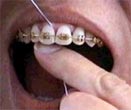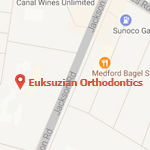Brushing & Flossing
BRUSHING AND FLOSSING
Food particles and plaque naturally accumulate on the teeth and on braces. This process could lead to tooth decay and/or gum disease. Proper oral hygiene is vital to prevent these problems from occurring during your orthodontic treatment. The extra effort you give to keep your teeth, braces and gums clean and healthy will result in a much better orthodontic outcome.
- Brushing
- Flossing
- Interdental Toothbrush
- Mouth Rinse
- Prevident
- Cleaning a Removable Appliance
BRUSHING
Dr. Sarkis Euksuzian recommends that you use a soft bristled toothbrush with moderate force and a toothpaste that contains fluoride. Place the toothbrush at an angle so that you feel the bristles under your gum line and use small circular motions. Completely clean each surface of every tooth in your mouth, including the areas above, below and between each brace. Each surface of every tooth should be scrubbed with 10 strokes of the toothbrush. This should take 2-3 minutes.
Dr. Sarkis Euksuzian recommends that you brush at least 4 times per day: after breakfast, after lunch (or as soon as you get home from school), after supper and at bedtime. Your toothbrush will wear out faster because of your appliances, so be sure to replace it whenever the bristles start to fray.
 1. Use a soft toothbrush with a small amount of toothpaste. Completely clean each surface of every tooth in your mouth, including the areas above, below and between each brace. 1. Use a soft toothbrush with a small amount of toothpaste. Completely clean each surface of every tooth in your mouth, including the areas above, below and between each brace. |
 2. Use circular, vibrating motions around the gum line. Scrub each surface of every tooth with 10 strokes of the toothbrush. This should take 2-3 minutes. 2. Use circular, vibrating motions around the gum line. Scrub each surface of every tooth with 10 strokes of the toothbrush. This should take 2-3 minutes. |
 3. Brush every tooth slowly. Brush the upper teeth down. 3. Brush every tooth slowly. Brush the upper teeth down. |
 4. Brush the lower teeth up. Also brush your tongue and the roof of your mouth 4. Brush the lower teeth up. Also brush your tongue and the roof of your mouth |
Remember that a toothbrush might not reach the areas under the archwire properly. Proper oral hygiene also involves flossing and the use of an interdental toothbrush (Proxabrush), an antiseptic mouth rinse (Peroxyl) and a topical fluoride (Phos-Flur).
FLOSSING
For areas between the teeth that a toothbrush can’t reach, use dental floss to remove food particles and plaque. Flossing takes more time and patience when you are wearing braces, but it is important to floss your teeth every day.
Use the reuseable floss threader provided by our office to floss under your archwire daily. Pull a small length of floss from the dispenser through the threader and slide it up and down along the front of each tooth. You will be able to feel when the tooth is clean and hear the squeak of the floss against your clean teeth. Use care around your archwire and do not floss too forcefully around it or put too much pressure on it. After you floss between your archwire and braces, floss between your other teeth and gums.
If you are flossing without the floss threader, pull a small length of floss from the dispenser. Wrap the ends of the floss tightly around your middle fingers. Guide the floss between all teeth to the gum line, pulling out food particles or plaque. Unwrap clean floss from around your fingers as you go, so that you have used the floss from beginning to end when you finish. Floss behind all of your back teeth.
Floss at night to make sure your teeth are clean before you go to bed. When you first begin flossing around your braces, your gums may bleed a little. If the bleeding does not go away after the first few times, inform a staff member at your next appointment.

1. Carefully pull waxed floss between |
 2. Floss carefully around the gum area. 2. Floss carefully around the gum area. |
INTERDENTAL TOOTHBRUSH
An interdental toothbrush (Proxabrush) is another aid you may find useful to keep your teeth, braces and gums clean and healthy. It can be used to clean under orthodontic wires and around braces. Use this device slowly so you do not damage your braces.
ANTISEPTIC MOUTH RINSE (PEROXYL) Peroxyl is an antiseptic dental rinse (active ingredient: hydrogen peroxide 1.5%) used in orthodontics to control minor gum inflammation and irritations from orthodontic appliances. It is also used to cleanse canker sores and minor wounds or other irritations of the mouth and gums such as mouth burns, cheek bites and toothbrush abrasions. Its oxygenating action removes debris allowing natural healing to occur.
Dr. Sarkis Euksuzian recommends that you rinse with half a capful (two (2) teaspoons) around in the mouth for at least one (1) minute, then spit out. Use up to four (4) times daily after meals and at bedtime while wearing orthodontic appliances.
PREVIDENT
Prevident is a toothpaste with a very high floride concentration. Prevident can only be purchased at the drugstore with a prescription from Dr. Sarkis Euksuzian . We recommend brushing with it once a day at bedtime to help minimize the chances of decay.
CLEANING A REMOVABLE APPLIANCE
All orthodontic appliances tend to accumulate food particles and plaque just like teeth do. Every time you brush your teeth, brush your removable appliance. Once a day you should soak your appliance in a glass of room temperature tap water with a denture-cleaning tablet, such as Polident or Efferdent. This will help prevent plaque buildup and oral infections and will keep your appliance tasting better.


